
Max Ernst was a German painter, sculptor, printmaker, graphic artist, and poet. A prolific artist, Ernst was a primary pioneer of the Dada movement and Surrealism in Europe. He had no formal artistic training, but his experimental attitude toward the making of art resulted in his invention of frottage—a technique that uses pencil rubbings of textured objects and relief surfaces to create images—and grattage, an analogous technique in which paint is scraped across canvas to reveal the imprints of the objects placed beneath. Ernst is noted for his unconventional drawing methods as well as for creating novels and pamphlets using the method of collages. He served as a soldier for four years during World War I, and this experience left him shocked, traumatised and critical of the modern world. During World War II was designated an "undesirable foreigner" while living in France. He died in Paris on 1 April 1976.
Surrealism in art, poetry, and literature uses numerous techniques and games to provide inspiration. Many of these are said to free imagination by producing a creative process free of conscious control. The importance of the unconscious as a source of inspiration is central to the nature of surrealism.

The Persistence of Memory is a 1931 painting by artist Salvador Dalí and one of the most recognizable works of Surrealism. First shown at the Julien Levy Gallery in 1932, since 1934 the painting has been in the collection of the Museum of Modern Art (MoMA) in New York City, which received it from an anonymous donor. It is widely recognized and frequently referred to in popular culture, and sometimes referred to by more descriptive titles, such as "Melting Clocks", "The Soft Watches" or "The Melting Watches".
Gordon Onslow Ford was one of the last surviving members of the 1930s Paris surrealist group surrounding André Breton.

Katherine Linn Sage, usually known as Kay Sage, was an American Surrealist artist and poet active between 1936 and 1963. A member of the Golden Age and Post-War periods of Surrealism, she is mostly recognized for her artistic works, which typically contain themes of an architectural nature.
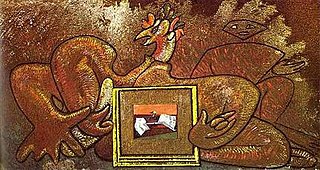
Loplop, or more formally, Loplop, Father Superior of the Birds, is the name of a birdlike character that was an alter ego of the Dada-Surrealist artist Max Ernst. Ernst had a ongoing fascination with birds, which often appear in his work. Loplop functioned as a familiar animal. William Rubin wrote of Ernst "Among his more successful works of the thirties are a series begun in 1930 around the theme of his alter ego, Loplop, Superior of the Birds." Loplop is an iconic image of surrealist art, the painting Loplop Introduces Loplop (1930) appears on the front cover of the Gaëtan Picon's book Surrealist and Surrealism 1919-1939, and the drawing and collage Loplop Presents (1932) was used as the frontispiece of Patrick Waldberg's book Surrealism.

Wolfgang Robert Paalen was an Austrian-Mexican painter, sculptor, and art philosopher. A member of the Abstraction-Création group from 1934 to 1935, he joined the influential Surrealist movement in 1935 and was one of its prominent exponents until 1942. Whilst in exile in Mexico, he founded his own counter-surrealist art-magazine DYN, in which he summarized his critical attitude towards radical subjectivism and Freudo-Marxism in Surrealism with his philosophy of contingency. He rejoined the group between 1951 and 1954, during his sojourn in Paris.

The Garden of Earthly Delights is the modern title given to a triptych oil painting on oak panel painted by the Early Netherlandish master Hieronymus Bosch, between 1490 and 1510, when Bosch was between 40 and 60 years old. It has been housed in the Museo del Prado in Madrid, Spain since 1939.
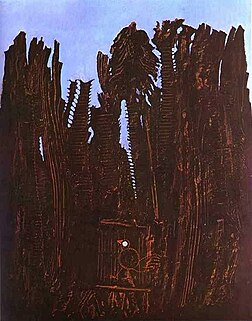
Forest and Dove (1927) is a painting by the German surrealist Max Ernst. It depicts a nocturnal scene of a forest of bizarre, abstract trees. In the thick of the forest is a childlike depiction of a dove.
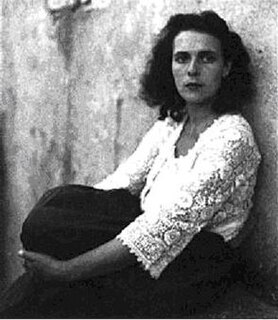
Mary Leonora Carrington was a British-born Mexican artist, surrealist painter, and novelist. She lived most of her adult life in Mexico City and was one of the last surviving participants in the surrealist movement of the 1930s. Carrington was also a founding member of the women's liberation movement in Mexico during the 1970s.

The Elephant Celebes is a 1921 painting by the German Dadaist and surrealist Max Ernst. It is among the most famous of Ernst's early surrealist works and "undoubtedly the first masterpiece of Surrealist painting in the de Chirico tradition." It combines the vivid dreamlike atmosphere of Surrealism with the collage aspects of Dada.
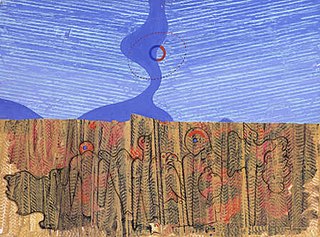
The Wood (1927) is a painting by the German surrealist Max Ernst.
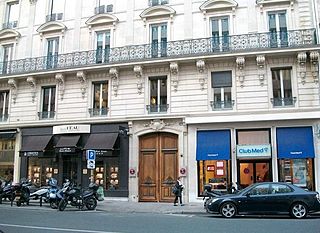
The Exposition Internationale du Surréalisme was an exhibition by surrealist artists that took place from January 17 to February 24, 1938, in the generously equipped Galérie Beaux-Arts, run by Georges Wildenstein, at 140, Rue du Faubourg Saint-Honoré in Paris. It was organised by the French writer André Breton, the surrealists' brain and theorist, and Paul Éluard, the best known poet of the movement. The catalogue listed, along with the above, Marcel Duchamp as generator and arbitrator, Salvador Dalí and Max Ernst as technical advisers, Man Ray as head lighting technician and Wolfgang Paalen as responsible for the design of the entrance and main hall with "water and foliage". The exhibition was staged in three sections, showing paintings and objects as well as unusually decorated rooms and mannequins which had been redesigned in various ways. With this holistic presentation of surrealist art work the movement wrote exhibition history.

The Fall of the Rebel Angels is an oil-on-panel painting of 1562 by the Netherlandish Renaissance artist, Pieter Bruegel the Elder. The painting is 117cm x 162cm and is now in the Royal Museums of Fine Arts of Belgium in Brussels, Belgium. The Fall of Rebel Angels depicts Lucifer along with the other fallen angels that have been banished from heaven. Angels are falling from the sun in a stacked manner along with ungodly creatures that Bruegel created. This piece by Bruegel was previously thought to be by Hieronymus Bosch. Bruegel was influenced by a variety of artists such as Albrecht Dürer, Frans Floris I, and Hieronymus Bosch. He also got ideas for the creation of his creatures in his previous works.
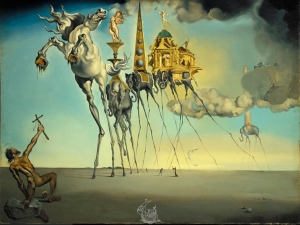
The Temptation of St. Anthony is a painting by Spanish surrealist artist Salvador Dalí. Painted in 1946, it is a precursor to the body of Dalí's work commonly known as the "classical period" or the "Dalí Renaissance".

Leon Kelly was an American artist born in Philadelphia, Pennsylvania. He is most well known for his contributions to American Surrealism, but his work also encompassed styles such as Cubism, Social Realism, and Abstraction. Reclusive by nature, a character trait that became more exaggerated in the 1940s and later, Kelly's work reflects his determination not to be limited by the trends of his time. His large output of paintings is complemented by a prolific number of drawings that span his career of 50 years. Some of the collections where his work is represented are the Metropolitan Museum in New York, The Whitney Museum of American Art, the Museum of Modern Art, the Philadelphia Museum of Art, and Boston Public Library.
Proto-Surrealism is a term used for Surrealism avant-la-lettre. It is the study of various forms of art, literature, and other mediums that correspond to, reference, or share similarities to the 20th-century art movement known as Surrealism. This definition is considered a controversial topic, with many debating the suitability of the term surrealism to describe these bodies of work and instead opting to use the term Fantastique or Fantastic Art.

Grattage is a technique in surrealist painting which consists of "scratching" fresh paint with a sharp blade.
Kikuji Yamashita was a Japanese Surrealist painter associated with the postwar avant-garde art movement in Japan. His artworks were featured prominently in the 2010 documentary film ANPO: Art X War by American documentary filmmaker Linda Hoaglund.
Portrait of Max Ernst, also known as Bird Superior - Portrait of Max Ernst, is an oil on canvas painting by English artist Leonora Carrington, created c. 1939. The painting was made when the two artists were having a short-lived affair. It is held at the Scottish National Gallery of Modern Art, who purchased it in 2018. It was the first work by the artist acquired by the museum.















